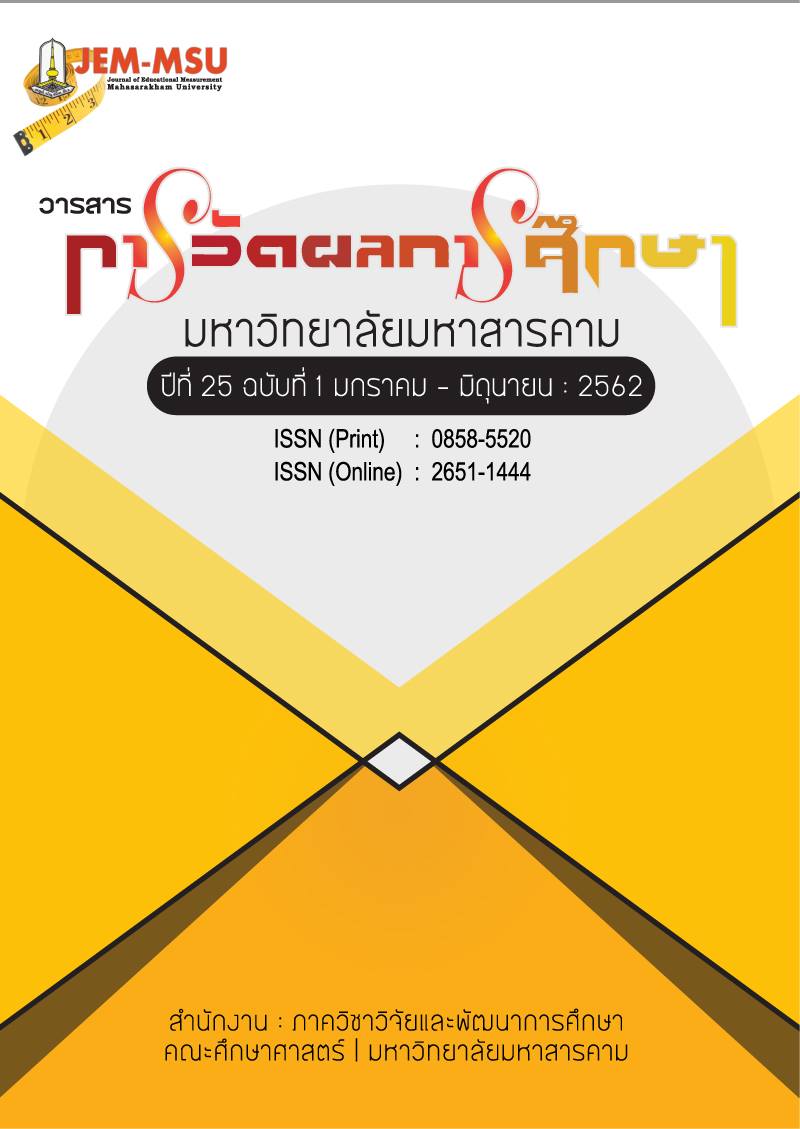Development of an Activity Package for Executive Function Enhancement on Self-regulation of Early Childhood Children with Risk of Attention Deficit Hyperactivity Disorder
Main Article Content
Abstract
The objectives of this research were: 1) to screen early childhood children with risk of attention deficit hyperactivity disorder; 2) to develop an activity package for executive function promotion on self-regulation of children with risk of attention deficit hyperactivity disorder; and 3) to study the efficiency of the activity package for executive functions promotion on self-regulation of children with risk of attention deficit hyperactivity disorder. The sample comprised 12 K3 students in the academic year 2017 of Si Sawat Wittaya Municipal School, Talad Sub-district, Muang Mahasarakham District, Mahasarakham Province, obtained through purposive sampling, using the Conners Teacher Questionnaire. The tools used in this research were: 1) the activity package for executive function promotion on self-regulation of K3 students; 2) an assessment form for self-regulation behavior (for teacher/ researcher), 3) a log of self-regulation behavior observation. The research followed the Research and Development process which comprised 3 phases. Phase 1 dealt with the screening of early childhood children with risk of attention deficit hyperactivity disorder; Phase 2 dealt with development of the activity package for executive function promotion on self-regulation; Phase 3 dealt with the study on the result of using the activity package for executive function promotion on self-regulation. The statistics employed in the analysis of data were percentage, the mean and standard deviation.
The research findings revealed the following:
1. The screening of children with risk of attention deficit hyperactivity disorder, by the teacher, using the Conners Teacher Questionnaire, revealed that the average score of all 35 children was 26.6; 13 children or 37.14 percent had no behavior of disturbing the class; 7 children or 20.00 percent had the behavior of disturbing the class just a little; 4 children or 11.43 percent had the behavior of disturbing the class moderately; and 1 child or 2.85 percent had the behavior of disturbing the class very much. The results of the screening indicated that 12 children had attention deficit hyperactivity disorder.
2. The development of the activity package for executive function promotion on self-regulation of K3 students yielded 5 units of creative learning activities. Each unit consisted of the name of the activity, the main point, the learning purposes, the learning strand, the learning activities, the learning media, and assessment. The record of post-teaching consisted of the result of activity held, the problems and obstacles and the suggestion/solution. As assessed by experts, it was found that the assessment result of the learning activities and the activity package for executive function on self-regulation of early childhood children were highly appropriate.
3. The study on the efficiency of the activity package for executive function promotion on self-regulation of children with risk of attention deficit hyperactivity disorder revealed the average score, while going through the experience, was 228.25 from 300, representing 76.08 percent, and after the experience the average score was 11.65 out of 15, representing 77.67 percent. Therefore, holding the learning activities for promotion of executive function on self-regulation of early childhood children with risk of attention deficit hyperactivity disorder had the efficiency (E1/E2) of 76.08/77.67, which was higher than the preset criterion of 75/75.
Article Details
The content and information contained in the published article in the Journal of Educational Measurement Mahasarakham University represent the opinions and responsibilities of the authors directly. The editorial board of the journal is not necessarily in agreement with or responsible for any of the content.
The articles, data, content, images, etc. that have been published in the Journal of Educational Measurement Mahasarakham University are copyrighted by the journal. If any individual or organization wishes to reproduce or perform any actions involving the entirety or any part of the content, they must obtain written permission from the Journal of Educational Measurement Mahasarakham University.
References
กุลยา ตันติผลาชีวะ. (2551). การจัดกิจกรรมการเรียนรู้สำหรับเด็กปฐมวัย. กรุงเทพฯ: เบนร-เบส บุ๊ค.
จิระพร ชะโน. (2561). การพัฒนารูปแบบการจัดการเรียนรู้การคิดเชิงบริหารเพื่อส่งเสริมความพร้อมทางการเรียนของเด็กปฐมวัยที่มีภาวะสมาธิสั้น. มหาวิทยาลัยมหาสารคาม.
จินดารัตน์ โพธิ์นอก. (2559). วุฒิภาวะ. [ออนไลน์] ได้จาก: https://www.dailynews.co.th/article [สืบค้นเมื่อ 25 ธันวาคม 2559].
ชาญวิทย์ พรนภดล. (2558). มารู้จักและช่วยเด็กสมาธิสั้นกันเถอะ. [ออนไลน์] ได้จาก: https://www.si.mahidol.ac.th/th/department/psychiatrics/cap/article/ADHD%20articlePfchan.pdf [สืบค้นเมื่อ 25 ธันวาคม 2559].
ทวีศักดิ์ สิริรัตน์เรขา. (2547). การจัดประสบการณ์การเรียนรู้เพื่อส่งเสริมพัฒนาการของเด็กปฐมวัย. [ออนไลน์] ได้จาก: https://wbscport.dusit.ac.th/artefact/file/download.php?file=178181&view=130722 [สืบค้นเมื่อ 25 ธันวาคม 2559].
ทวีศิลป์ วิษณุโยธิน และคณะ. (2556). ความชุกของโรคสมาธิสั้นในประเทศไทย. วารสารสุขภาพจิตแห่งประเทศไทย, 22(2), 66-75
ภัทราภรณ์ สังข์ทอง. (2550). พัฒนาการของการเรียนรู้โดยการกำกับตนเองของนักเรียนช่วงชั้นที่ 2 ที่มีการรับรู้ความสามารถของตนเองต่างกัน สังกัดสำนักงานเขตพื้นที่การศึกษานนทบุรีเขต 1. (ปริญญานิพนธ์การศึกษามหาบัณฑิต มหาวิทยาลัยศรีนครินทร์วิโรฒ).
สาลินี จงใจสุรธรรม, นำชัย ศุภฤกษ์ชัยสกุล และวินัย ดำสุวรรณ. (2558). กลวิธีการกำกับตนเองในการเรียนรู้ในศตวรรษที่ 21. วารสารพฤติกรรมศาสตร์เพื่อการพัฒนา, 7(1), 15-26.
สิรินทร์ ลัดดากลม บุญเชิดชู และ พาสนา จุลรัตน์. (2557). ผลของรูปแบบการจัดการเรียนรู้แบบ SSAPA ที่มีต่อการกำกับตนเองของเด็กปฐมวัย. วารสารศิลปากรศึกษาศาสตร์วิจัย, 6(2), 244-258.
Sinha, P., Sagar, R. and Mehta, M. (2008). Executive Function in Attention Deficit/Hyperactivity Disorder. Journal of Indian Association for Child and Adolescent Mental Health, 4(2), 44-49.
Workman, S.L. (2002). Expressive arts therapy for a boy with ADHD, learning disabilities and divorce issues. Ursuline College.

